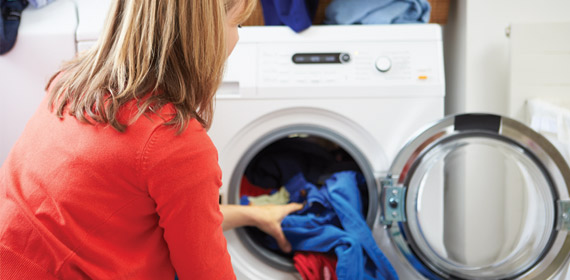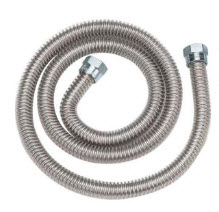Natural gas appliances and safety tips
Follow these tips to stay safe with natural gas appliances

Storing flammable liquidsThe most common flammable liquids are gasoline, solvents, paint thinners and adhesives. These liquids all produce fumes that will ignite if they come into contact with a flame or spark from any source. These fumes are heavier than air and can be carried along the floor by air currents and potentially to the pilot and main burner flames of gas appliances or appliances with electric motors or switches. For this reason, most building codes require that water heaters installed in the garages of newly constructed homes be elevated 18 inches above the floor. Most newer water heaters built with sealed combustion chambers may be exempt from this rule. Elevating the water heater can reduce the risk of fire or explosion, but it does not eliminate the risk. For more safety protection, you should store all flammables away from any gas or electric appliances.
Natural gas range
- Never use natural gas ranges for space heating. Using a range as a source of heat can cause dangerous levels of Carbon Monoxide (CO) to build up in your home or building.
- Call CenterPoint Energy if you notice a pilot flame suddenly burning much higher than normal because it might be a surge in gas pressure.
Water heater
- Set your water heater temperature to 120°F (low or warm). Water heaters set at 140°F or higher pose a potential danger, especially to children and the elderly. It takes just five seconds to receive a third-degree burn from 140°F water. You should always feel the water before bathing or showering.
- Temperature-limiting valves are available. Check your owner's manual for information.
Natural gas fireplaces
- Before lighting the first fire of the season, keep these safety tips in mind:
- Have a technician check the gas lines and clean the burner, control compartment, fan and related air circulation passages.
- Ensure vents are unobstructed and able to do their job.
- Check the batteries in the carbon monoxide detector.
- Clean the glass and adjust the glowing embers and logs for best appearance.
- Be alert for unusual odors or flames, which are often a sign that the fireplace is not operating properly.
- Make family members and guests aware that the glass panel of a gas fireplace, stove, or insert can be very hot. Installing a safety screen or safety barrier is recommended to reduce the risk of serious burns by preventing direct contact with hot glass.
Natural gas grill
- Never use your natural gas grill inside a garage, in an enclosed porch or directly under low eaves or overhangs.
- Keep your grill at a safe distance from wood siding, deck railings and other surfaces that could ignite.
Natural gas dryer
Remove any lint or obstruction from your clothes dryer's exhaust duct, vent and hood cover (outside the house) periodically. Lint is highly flammable. When a dryer becomes clogged with lint, the heat is trapped, causing the equipment to overheat, and increasing the probability for the lint to catch fire. Warning signs that your dryer vent may have some obstructions and need cleaning:
- Increased drying time.
- Clothes and the dryer may be hot to the touch after a complete dry cycle. Dryers should cool down at the end of the cycle.
- Humidity in the laundry room when the dryer is in use. Too much humidity and heat could be a sign of a poorly maintained dryer.
Natural gas heating system
- Have a qualified technician check your heating system annually. Technicians check for proper combustion, carbon monoxide levels and flue gas temperature, burners and the heat exchanger to ensure proper operation

Natural gas appliance connector warning
Natural gas connectors are corrugated metal tubes that connect the natural gas appliances of a home or business to a fuel source. The U. S. Consumer Product Safety Commission warns natural gas users that older brass, uncoated appliance connectors can come apart, causing fires and explosions resulting in deaths and injuries. Newer connectors are made of stainless steel or plastic-coated metal.
Defective connectors are most often found on natural gas ranges, ovens and clothes dryers (sometimes on water heaters and furnaces) that are 20 years old or older. If you suspect you may have an uncoated, brass connector, follow these simple steps:
- NEVER move the appliance or disturb the connector. This could cause the connector to break, which could cause a fire or explosion.
- Schedule a qualified plumber or heating dealer to inspect the connector. NEVER try to do this yourself.
- If necessary, ask the qualified technician to replace the old connector with a new model certified by the American Gas Association.
- Replace all uncoated brass connectors immediately.
Moving and replacing natural gas appliances
- Do not move, install, replace or remove natural gas appliances yourself. Have a professional or licensed plumber move your appliances as you could damage the gas lines or cause a natural gas leak. Also, if you come across a gas valve that isn’t connected to an appliance, please ensure that the valve is not only in the off position, but that it also is capped to prevent accidental release of gas should the valve be inadvertently turned on.
Before clearing a blocked sewer line contact CenterPoint Energy before anyone attempts to clear the blockage.